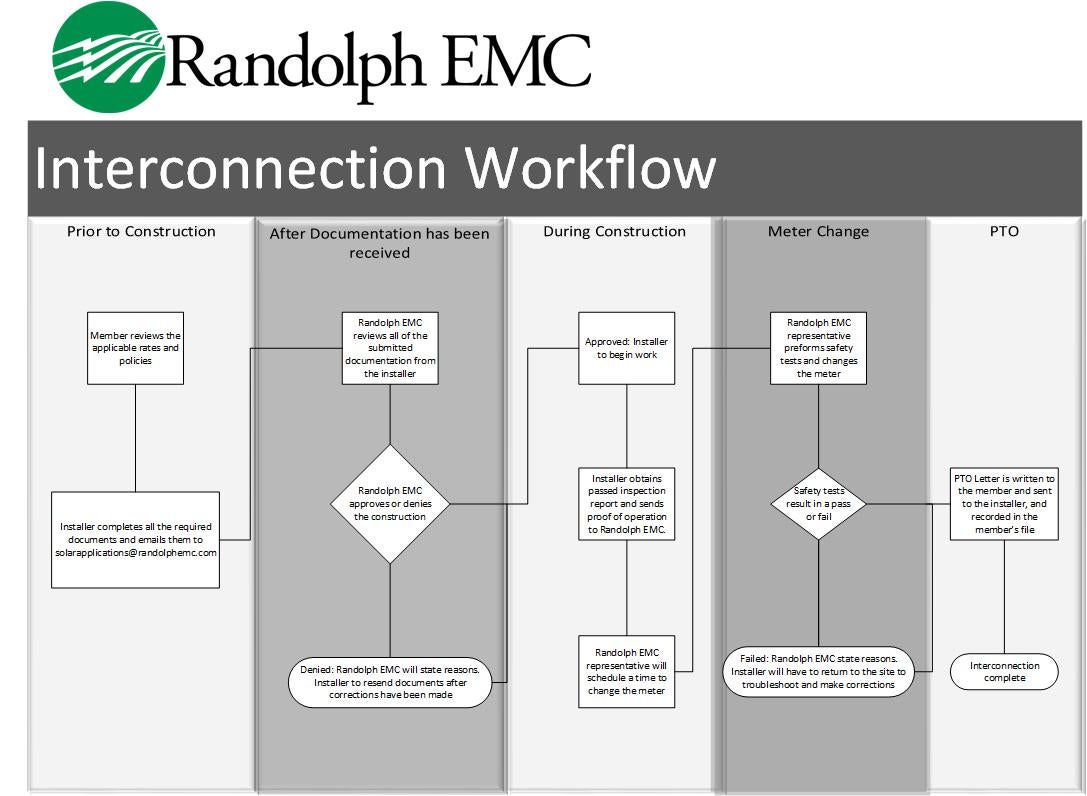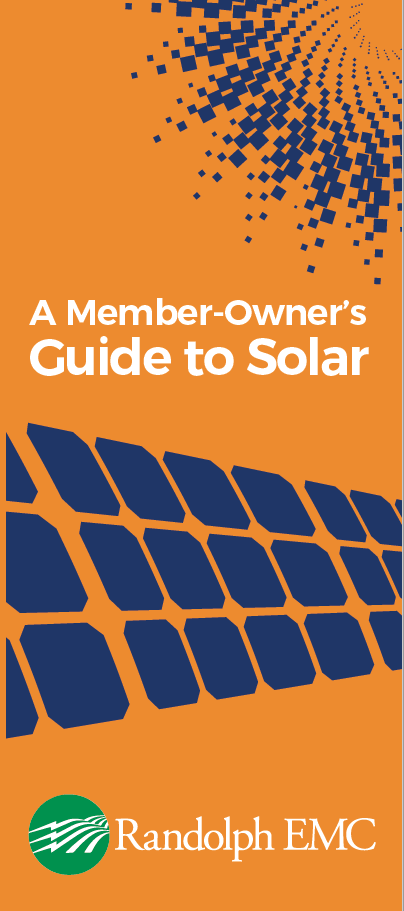Randolph Electric Membership Corporation supports innovative renewable energy resources for the future. "Green" power is a cleaner alternative to traditional fossil fuels. Using renewable energy sources such as wind, solar and organic matter is a good way to protect the environment now and help ensure adequate energy supply for the future. Randolph EMC supports many renewable projects across the state, involving hydroelectric, landfill gas and solar generation to name a few. REMC will purchase 100 percent of the power produced by qualifying facilities in our service territory.
Ready to Interconnect?
The interconnection process is easy! To begin, download the appropriate form below and return it to your local office.
Residential Solar Interconnection Checklist
Interconnection Agreement for Facilities Less Than 100 kW
Renewable Project Interconnection Process and Queue Positioning
Interconnection Application for Facilities with Capacity of 500kW or Less
Interconnection Application for Facilities with Capacity Greater Than 500kW
Solar Installation Frequently Asked Questions
As a Randolph EMC member-owner, you have access to low-cost electricity compared to other national averages. It can take up to 25 years or more for most solar installations in our area to realize the total financial payback on their investments through power bill savings, depending on the total solar project cost. Solar project costs can vary greatly depending on the equipment, financing, and installation company.
It is imperative that you, or your solar installer, contact Randolph EMC early in the process to ensure all required documents and permits are in place before installation.
List of Required Items
-
Interconnection Application Form
-
Duplicate of NCUC Compliance
-
Interconnection Agreement
-
One-Line Diagram of the System
-
Certificate of Insurance
-
Application Fee
-
City/County Inspection
-
REMC Onsite Inspection
Randolph EMC requires all generation systems to go through our application process.
Randolph EMC currently has two billing options for members who install solar on their homes:
-
A two-meter, buy-all sell-all option.
One meter measures all usage consumed by the home, and the additional meter measures all energy produced from the solar system. Your account is credited for the total energy produced at the avoided wholesale cost rate.
-
A one-meter, net billing rider.
Member-owners can use their solar system to power the home directly. The cooperative provides electricity when the solar array is not actively powering the house. If the solar panels produce more electricity than the home needs, the cooperative credits this amount to the member's account at the avoided wholesale cost rate.
The tax incentives for installing solar continue to change. Visit https://www.dsireusa.org/ for an updated list of state & federal incentives for renewable energy installations.
Randolph EMC does not install or maintain photovoltaic (PV) systems, so you will purchase a system from a contractor who is not part of the cooperative. In most cases, solar companies will actively seek landowners for leasing opportunities to install large-scale solar projects.
Most solar arrays are designed to provide only a portion of the electricity needed and will not provide 100 percent of your needs. Your Randolph EMC Energy Advisors can review your past energy use to help you understand how much solar electricity is required to meet your goals. Examining how your energy use fluctuates throughout the day will help your solar contractor determine the size and type of system to fit your needs. The National Renewable Electric Laboratory (NREL) has a calculator you can use to estimate your solar energy production. https://pvwatts.nrel.gov/index.php.
A good solar company will take time to understand your goals and whether or not it makes sense to install a system at your home or property. From the beginning, they will involve your electric cooperative to discuss the best solution.
Go to the Energy Sage website to access a network of pre-screened, local installers. https://www.energysage.com/
The price of solar has fallen around 20 percent over the past five years but is still represents a significant investment. Several factors determine the cost of your solar energy system:
-
Where you live
-
How much electricity you use
-
The equipment you choose for your solar system
-
The solar financing option
-
The installation company
As with any major purchase, you will need to do plenty of research before choosing an installer. Below are some questions to ask when trying to find the right installer.
- How many years have you been in the business?
- What installations have you completed?
- Can you provide a list of references for me to contact?
- What financial assumptions regarding utility costs were used in determining my payback?
- What payment options do you offer?
- Do you handle the paperwork for tax credits?
- Will my roof be strong enough to handle the weight of the solar panels?
- Do you have a builder's permit and electrician's license?
- What type of insurance do you carry?
Most solar electric systems have a 20- to 25-year output warranty, and most inverter warranties have around 10 years of coverage. As the owner of the system, you will be responsible for maintenance and system repairs. Be sure you understand your ownership responsibilities before signing any solar contracts.
The cost of battery storage is significant and can cost nearly as much as installing solar on its own. When looking at storage for solar or as a standalone system, the decision really comes down to your goals and the cost to achieve those goals. Typically, most people purchase battery storage for resilience, but a battery system paired with a time-of-use rate can bring additional savings. Contact our Energy Advisors to make sure your goals are met before purchasing a battery storage system.


